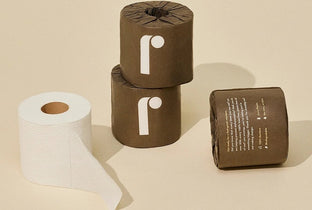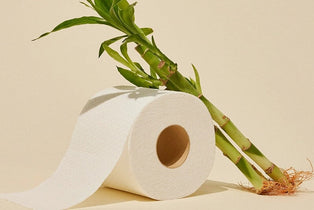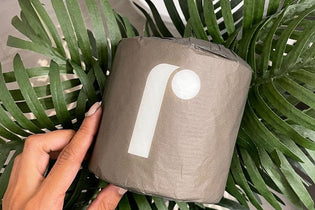
TLDR
The recent surge in the popularity of bamboo toilet paper has brought with it a flurry of questions, primarily concerning its cost. Many consumers wonder why bamboo toilet paper, such as the products offered by Reel Paper, is perceived as more expensive compared to traditional toilet paper.
This article delves into the economics behind bamboo toilet paper, its environmental impact, quality, and efficiency to understand its real cost and value. As we navigate the choices for our daily essentials, understanding the full picture behind product pricing, especially for sustainable swaps for the home, becomes crucial.
This aims to shed light on the factors that contribute to the pricing of bamboo toilet paper and to help consumers make informed decisions that align with their values and lifestyle choices. In a world increasingly conscious of environmental impacts, this exploration goes beyond just the price tag, delving into the broader implications of choosing sustainable products.
The Cost Comparison
When it comes to choosing between bamboo and traditional toilet paper, one of the primary considerations for many consumers, along with how much toilet paper to use, is often the cost. Understanding the price difference requires a deeper look into the production processes, environmental impacts, and economies of scale for both types of products. This section compares the costs involved in the production of regular toilet paper and bamboo toilet paper, shedding light on why there might be a price disparity and what this means for consumers.
Production Costs of Regular Toilet Paper
The production of regular toilet paper predominantly uses virgin wood pulp, sourced from cutting down trees, which involves a process that's both resource-intensive and environmentally taxing.
Every ton of toilet paper produced requires about 1.75 tons of raw fiber, and the amount of wood harvested annually may need to triple by 2050 to meet projected global demands. This traditional manufacturing process includes significant water usage, energy consumption, and chemical processing. While mass production and established supply chains help keep prices low, the environmental costs, such as deforestation and its long-term economic impacts, are often overlooked. These hidden costs of environmental degradation and resource depletion can have far-reaching consequences that aren't immediately reflected in the price of toilet paper.
Investing in sustainable alternatives or production methods, such as using recycled materials or eco-friendly manufacturing processes, can help mitigate these impacts. Additionally, considering the long-term benefits and cost savings, investing in more sustainable production methods, can be a worthwhile decision.
The Economics of Bamboo Toilet Paper
As the bamboo toilet paper market is still developing, the scale of production is relatively smaller compared to traditional toilet paper, which can affect pricing.
As demand increases and production scales up, the cost of bamboo toilet paper will likely become more competitive, potentially aligning closer to that of regular toilet paper while maintaining its environmental benefits.
MYTH: Bamboo Toilet Paper Is Much More Expensive Than Regular Toilet Paper
It's time to bust a myth that's been swirling around as much as...well, let's just say it's been around. The notion that bamboo toilet paper, like ours, is significantly more expensive than the regular kind is one we hear often. But, when you dive into the details, the reality paints a different picture. Let’s compare Reel to the leading toilet paper brand with those anthropomorphic bears as comparison.
Note: Prices reflect cost at the time this article was published, and may be subject to change.
Subscription Comparison
- Reel Paper Subscription: 24 rolls of bamboo toilet paper delivered every 8 weeks for $36.99.
- Leading Brand Subscription: 24 rolls for $33.72 under similar subscription terms.
With Reel's regular discounts and promotions, the slight price difference practically vanishes, making our subscription service a competitively priced, eco-conscious choice.
Retail Price Comparison
- Reel Paper at Target: 12 mega rolls for $18.29.
- Leading Brand at Target: 12 mega rolls for $16.19.
This difference is also minimal, especially considering the eco-friendly benefits of choosing bamboo.
In the end, it's not just about comparing prices—it's about valuing our planet. The marginal difference in cost is a small investment in a greener, more sustainable future. And that's a choice that feels as good as our bamboo toilet paper does.
The Sustainability Factor
In the debate between bamboo and traditional toilet paper, sustainability plays a crucial role. The impact of these products on the environment extends far beyond their immediate use and disposal. This section examines the sustainability aspects of both bamboo and regular toilet paper, focusing on how their production and disposal affect the environment and contribute to long-term ecological sustainability.
Environmental Benefits of Bamboo
Bamboo stands out for its exceptional environmental benefits. Its rapid growth rate makes it a highly renewable resource, minimizing its ecological footprint. Bamboo's ability to grow in a variety of climates and its natural pest resistance further enhance its environmental appeal. When used for products like toilet paper, bamboo helps reduce the reliance on traditional wood pulp, thereby aiding in the preservation of forests and reducing deforestation. This, in turn, has a positive impact on carbon sequestration and biodiversity.
Bamboo toilet paper is a more eco-friendly option, as it eliminates the need for virgin wood pulp, which is used to make traditional toilet paper. Bamboo toilet paper is also hypoallergenic and less likely to cause skin reactions, making it an ideal choice for individuals with sensitive skin or those prone to allergies.
Choosing bamboo-based household paper products like Reel Paper’s toilet tissue or bamboo paper towels is a step towards supporting sustainable forestry practices and reducing the overall environmental impact of generic paper products.
Long-Term Environmental Cost Savings
While the upfront cost of bamboo toilet paper might be higher than traditional options, the long-term environmental cost savings are significant. Sustainable bamboo cultivation leads to reduced environmental restoration costs and contributes to a healthier ecosystem, both of which are beneficial, specifically:
- Lower emissions: Bamboo toilet paper production releases 30% fewer carbon emissions than virgin-pulp toilet paper.
- Eco-friendly cultivation: Bamboo cultivation requires less water and no pesticides compared to traditional toilet paper production.
By supporting products that prioritize sustainability, consumers can play a part in reducing the demand for environmentally harmful practices. They’ll also enjoy some advantages themselves:
- Softness and comfort: Bamboo toilet paper is known for its exceptional softness and gentle texture, making it a comfortable choice for users.
- Hypoallergenic properties: Bamboo toilet paper is hypoallergenic and less likely to cause skin reactions, making it an ideal choice for individuals with sensitive skin or those prone to allergies.
In the long run, the shift towards more sustainable products like bamboo toilet paper can drive down the ecological costs associated with deforestation, water pollution, and chemical usage, making it a financially and environmentally sound choice for the future.
Quality and Efficiency
When evaluating the true cost of bamboo toilet paper, it's essential to consider not just its price but also its quality and efficiency. These factors can significantly influence the overall value and user experience. In this section, we'll delve into how bamboo toilet paper, such as Reel Paper's products, compares to traditional toilet paper in terms of absorbency, durability, and efficiency, and why these characteristics matter to consumers.
Absorbency and Durability
Bamboo toilet paper, including brands like Reel Paper, is often praised for its absorbency and durability. These properties make bamboo toilet paper more efficient in use, which can lead to using fewer sheets per visit compared to traditional toilet paper. This increased efficiency not only compensates for the cost but also provides a better experience for the consumer. The strength and absorbency of bamboo toilet paper mean that it's less likely to tear or disintegrate during use, offering both comfort and reliability.
Furthermore, many consumers find that the softness and hypoallergenic properties of bamboo toilet paper make it a preferable choice, especially for those with sensitive skin or allergies. The efficiency of bamboo toilet paper is not just in its use but also in its impact on plumbing and septic systems, where its biodegradable nature ensures it breaks down more quickly and easily, reducing the risk of clogs and maintenance issues.
The “Reel” Cost of Bamboo Toilet Paper
Indeed, while bamboo toilet paper may appear more expensive at first glance, its benefits outweigh the initial cost. The environmental advantages of using sustainable bamboo, the long-term cost savings due to its eco-friendly nature, and the quality and efficiency it offers make it a viable and wise choice for those looking to make sustainable swaps in their homes.
As more consumers opt for eco-friendly products like Reel Paper’s bamboo toilet paper as part of their sustainable New Year's resolutions or to simply improve the way they live, the industry is expected to grow, potentially leading to lower prices and more widespread adoption. In essence, when considering the real cost of bamboo toilet paper, it's important to factor in not just the price tag but also its positive impact on the environment and its contribution to a more sustainable future.
Supporting sustainable products like recycled paper towels, recycled facial tissues, and money-saving bulk toilet paper by Reel Paper not only aligns with eco-friendly values but also sets a precedent for a more responsible and environmentally conscious consumer culture.
Sources:
- World Wildlife Fund. 2015. “Price of Toilet Paper for the Planet | Magazine Articles | WWF.” World Wildlife Fund. 2015. https://www.worldwildlife.org/magazine/issues/spring-2015/articles/price-of-toilet-paper-for-the-planet.
- Childress, Ally. 2022. “Should You Convert to Bamboo Toilet Paper?” Family Handyman. October 20, 2022. https://www.familyhandyman.com/article/should-you-convert-to-bamboo-toilet-paper/.
- Cornell, Rai. 2020. “Bamboo Toilet Paper 101: Everything You Need to Know.” Reel. May 27, 2020. https://reelpaper.com/blogs/reel-talk/bamboo-toilet-paper-crash-course.
- Lester, Andrew. 2023. “Pros and Cons of Bamboo Toilet Paper.” Seek Bamboo. May 7, 2023. https://seekbamboo.com/blogs/sustainable-lifestyle/pros-and-cons-of-bamboo-toilet-paper.





0 comments